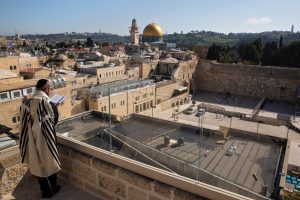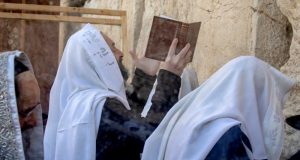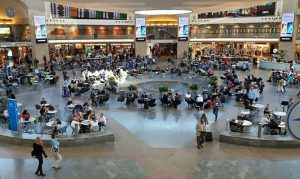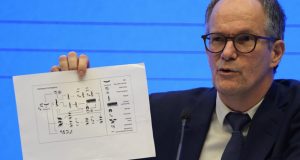Edited by: TJVNews.com
Every year, Jewish worshippers look forward to the third day of Passover when thousands of gather at Jerusalem’s Western Wall plaza to attend a special “priestly blessing” prayer known as Birkat Kohanim.
This year, due to the coronavirus pandemic and the limited attendance allowed at the site, the prayer is taking place on both the second and third days of Passover—Monday and Tuesday, according to a report in Israel HaYom.
Last year’s ceremony included only 10 priests, known in Hebrew as kohanim, who are residents of the Jewish Quarter of the Old City. This year’s ceremony marked the first time since the outbreak of the virus that kohanim across Israel were given permission to actively participate in the traditional event, as was reported by the JNS web site.

As is the case every year, the ceremony was attended by prominent religious and political leaders, among them Sephardic Chief Rabbi Yitzhak Yosef, Ashkenazi Chief Rabbi David Lau, Western Wall Rabbi Shmuel Rabinovitch, Religious Affairs Minister Ya’akov Avitan and Jerusalem Mayor Moshe Lion.
The Western Wall Heritage Foundation asked worshipers who attended the ceremony on Monday to refrain from doing so again on Tuesday, to enable others to participate, as was reported by JNS.
The priestly blessing at the Western Wall is traditionally held twice a year, on Passover and Sukkot, the feast of the Tabernacles.
“In order to meet the challenge of massive crowds coming from all over the country for the traditional Priestly Blessing, it was decided that this year Priestly Blessing will be split into two different events that will be held day after day to prevent overcrowding,” Western Wall Heritage Foundation said in a statement.
i24 News reported that in the morning, Jerusalem Police closed the main roads leading to the Old City, and thousands of officers and volunteers were deployed to the area to ensure the safety of the many worshipers.
Vehicle entry to the area and along some surrounding roads was stopped to further enable movement of those arriving at the site, Israel Police said. Police asked the public to avoid driving to the area and instead use public transport, as was reported by the Times of Israel.
This year, the Health Ministry permitted the ceremony to go ahead as usual, albeit with congregants divided into pods by clear plastic barriers and on the condition that hygiene rules were maintained, according to a Times of Israel report.
The ceremony is one in which male descendants of the Kohanim priestly caste gather to bestow a benediction upon the entire congregation. It involves the raising of hands to perform the blessing, with those conducting the blessing wrapped in prayer shawls, as was reported by the Times of Israel.

TOI reported that the Western Wall is the closest spot to the Temple Mount where Jews can pray. Though they may visit the Mount, where the two ancient Jewish Temples stood, Jews are not allowed to pray at the holy site, which is overseen by a Jordanian custodian.
Israel has gradually eased many of the restrictions applied to curb the virus spread. Infection rates plummeted following a third lockdown that lasted over a month and a world-beating inoculation program that already last week reached the milestone of immunizing over half of the population, according to the report. The government’s long term objective is to vaccinate the entire adult population by the end of April.
Prior to last week’s national elections in Israel, air travel restrictions were eased in traditionally one of the busiest weeks for air travel in Israel in advance of the Passover holiday, as was reported by World Israel News.
Israel shut down most entry to the country in January and maintained severe restrictions on air travel in order to prevent coronavirus mutations from entering. Following the High Court’s decision to strike down those constraints because they were too broad, the government then announced that the daily limit of only 3,000 air passengers was cancelled.
However, of the estimated 600,000 Israelis living or traveling abroad, few of them appeared to be in any hurry to return to vote in the national election March 23. Over the next few days, the number of people leaving Israel is expected to be greater than the number of people entering the country, Calcalist reported.
World Israel News reported that even with the cancelling of the restrictions, the scope of daily flights remains limited due to the need to comply with other corona regulations, including the need to test all incoming passengers and maintain social distancing inside the terminal.
Dozens of coronavirus testing stations have been set up in the arrivals hall and in a large tent adjacent to the terminal. Under social distancing limits of 2 meters (6 feet) between people, the terminal can accommodate only about 7,000 passengers a day. Airport officials are trying to reduce that distance to 1.5 meters to up the capacity, according to the WIN report.

Foreigners wishing to enter Israel still need to apply for permission before they leave their country of origin. The Ministry of Health warned that opening the skies could lead to the entry of dangerous virus variants into Israel, as was reported by WIN.
Israel’s national vaccination campaign to inoculate all of the 9.3 million citizens aged 16 and older, according to the WIN report. To date, 4.5 million Israelis have received both shots of the Pfizer vaccine, with another 660,000 having received their first injection.
Health Ministry statistics showed a continuing drop in the number of daily infections and active cases.
Also on Tuesday, the Associated Press reported that more than 20 heads of government and global agencies called in a commentary published for an international treaty for pandemic preparedness that they say will protect future generations in the wake of COVID-19.
But there were few details to explain how such an agreement might actually compel countries to act more cooperatively.
World Health Organization Director-General Tedros Adhanom Ghebreyesus and leaders including Prime Minister Boris Johnson of Britain, Premier Mario Draghi of Italy and President Paul Kagame of Rwanda proposed “a renewed collective commitment” to reinforce preparedness and response systems by leveraging the U.N. health agency’s constitution, as was reported by the Associated Press.
“The world cannot afford to wait until the pandemic is over to start planning for the next one,” Tedros said during a news conference. He said the treaty would provide “a framework for international cooperation and solidarity” and address issues like surveillance systems and responding to outbreaks.
AP reported that international regulations governing health and implemented by WHO already exist — and can be disregarded by countries with few consequences. Despite an obligation for nations to share critical epidemic data and materials quickly with WHO, for example, China declined to do so when the coronavirus first broke out.
And with no enforcement powers, WHO officials had little means of compelling them to share details, an AP investigation last year found.
Steven Solomon, WHO’s principal legal officer, said the proposed pandemic treaty would need to be ratified by lawmakers in the participating countries.
“Specifics about enforcement will be up to member states to decide on,” Solomon said.
European Council President Charles Michel first laid out the idea of a pandemic treaty at the U.N. General Assembly in December, according to the AP report. Joining Tedros at Tuesday’s briefing, Michel said the global community needs to “build a pandemic defense for future generations that extends far beyond today’s crisis. For this, we must translate the political will into concrete actions.”
Gian Luca Burci, a former WHO legal counsel who is now a professor at the Graduate Institute of international affairs in Geneva, described the proposal as an attempted “big fix” involving information sharing, preparedness and response, saying the concept is “like a Christmas tree, frankly.”
“But to me, the risk is that it diverts attention from the tool that we have” — WHO’s existing International Health Regulations, Burci said recently. He said his fear was those regulations would get short shrift and receive “cosmetic improvements, but fundamentally remain a weak instrument.”
Although the 25 signatories of the commentary called for “solidarity,” and greater “societal commitment,” there was no indication any country would soon change its own approach to responding to the pandemic. China, Russia and the United States didn’t join in signing the statement, according to the AP report.
White House press secretary Jen Psaki said the U.S. has concerns about the current push for a new pandemic treaty.
“We do have some concerns, primarily about the timing and launching into negotiations for a new treaty right now, and we believe that could divert attention away from substantive issues regarding the response, preparedness for future pandemic threats,” Psaki said Tuesday. “That should be our focus currently.”

AP reported that WHO legal officer Solomon said the pandemic treaty might also address issues such as the sharing of vaccine technology and vaccine supplies, but gave no indication how that might happen. Despite WHO’s calls for patents to be waived during the pandemic, rich countries have continued to oppose efforts by poor countries to compel them to share vaccine manufacturing technology.
Tedros pleaded with rich countries last week to immediately donate 10 million COVID-19 vaccines so that immunization campaigns could start in all countries within the first 100 days of the year. Not a single country has yet publicly offered to share its vaccines immediately. Of the more than 459 million vaccines administered globally, the majority have been in just 10 countries — and 28% in just one. WHO didn’t identify the countries.
AP reported on Monday on Monday that the head of the Centers for Disease Control and Prevention made an impassioned plea to Americans not to let their guard down in the fight against COVID-19, warning of a potential fourth wave of the virus and saying she has a recurring feeling “of impending doom.”
Speaking during a virtual White House briefing, Dr. Rochelle Walensky grew emotional as she reflected on her experience treating COVID-19 patients who are alone at the end of their lives, as was reported by the AP.
“We have so much to look forward to, so much promise and potential of where we are and so much reason for hope,” she said. “But right now, I’m scared.”
“I’m going to lose the script, and I’m going to reflect on the recurring feeling I have of impending doom,” she said, according to the AP report.
Cases of the virus are up about 10% over the past week from the previous week, to about 60,000 cases per day, with both hospitalizations and deaths ticking up as well, Walensky said. She warned that without immediate action the U.S. could follow European countries into another spike in cases and suffer needless deaths.
“I have to share the truth, and I have to hope and trust you will listen,” she added.
(Sources: Israel HaYom, JNS.org, i24News, Times of Israel, AP)




